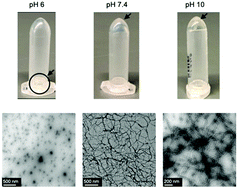Self-assembly of stimuli-responsive coiled-coil fibrous hydrogels†
Abstract
Owing to their tunable properties, hydrogels comprised of stimuli-sensitive polymers are one of the most appealing scaffolds with applications in tissue engineering, drug delivery and other biomedical fields. We previously reported a thermoresponsive hydrogel formed using a coiled-coil protein, Q. Here, we expand our studies to identify the gelation of Q protein at distinct pH conditions, creating a protein hydrogel system that is sensitive to temperature and pH. Through secondary structure analysis, transmission electron microscopy, and rheology, we observed that Q self-assembles and forms fiber-based hydrogels exhibiting upper critical solution temperature behavior with increased elastic properties at pH 7.4 and pH 10. At pH 6, however, Q forms polydisperse nanoparticles, which do not further self-assemble and undergo gelation. The high net positive charge of Q at pH 6 creates significant electrostatic repulsion, preventing its gelation. This study will potentially guide the development of novel scaffolds and functional biomaterials that are sensitive towards biologically relevant stimuli.



 Please wait while we load your content...
Please wait while we load your content...